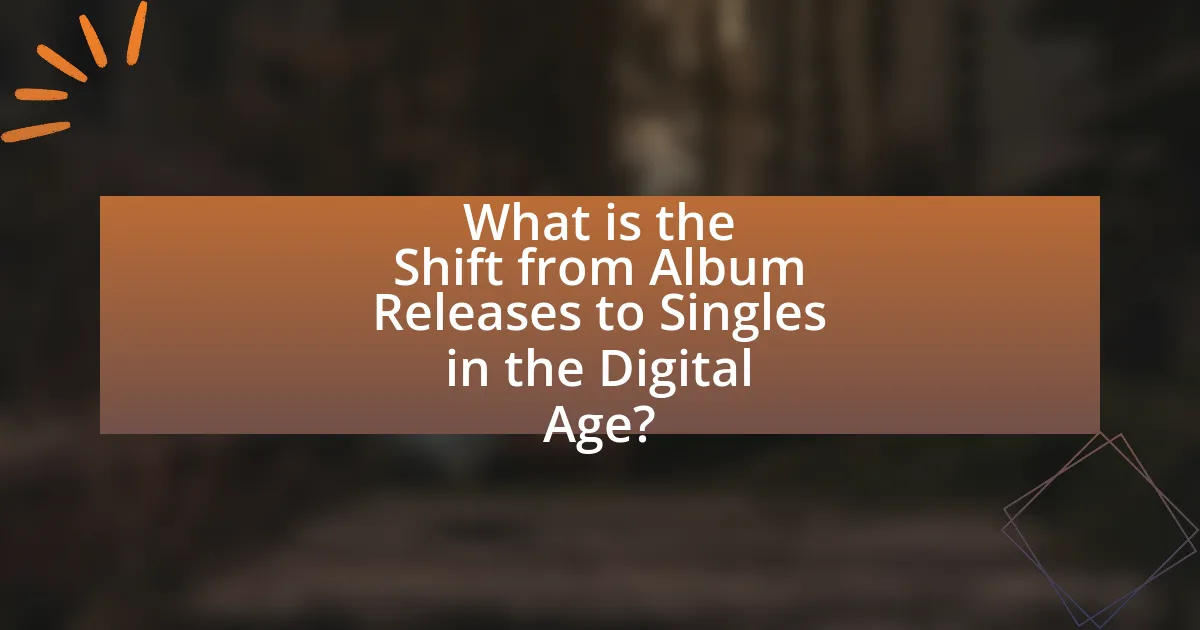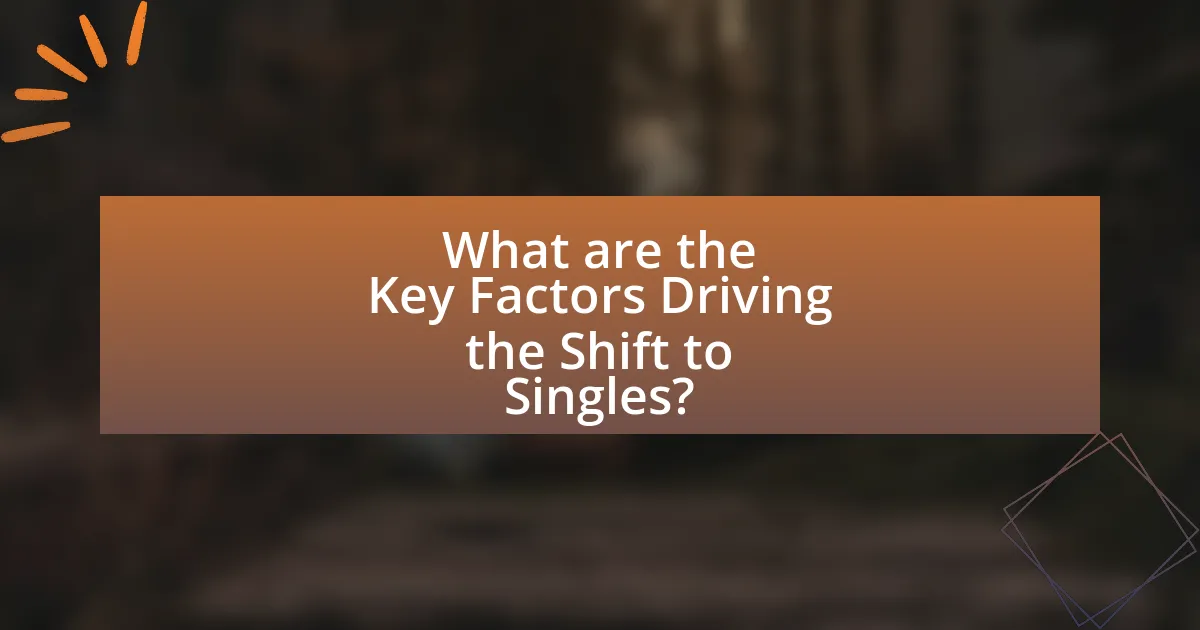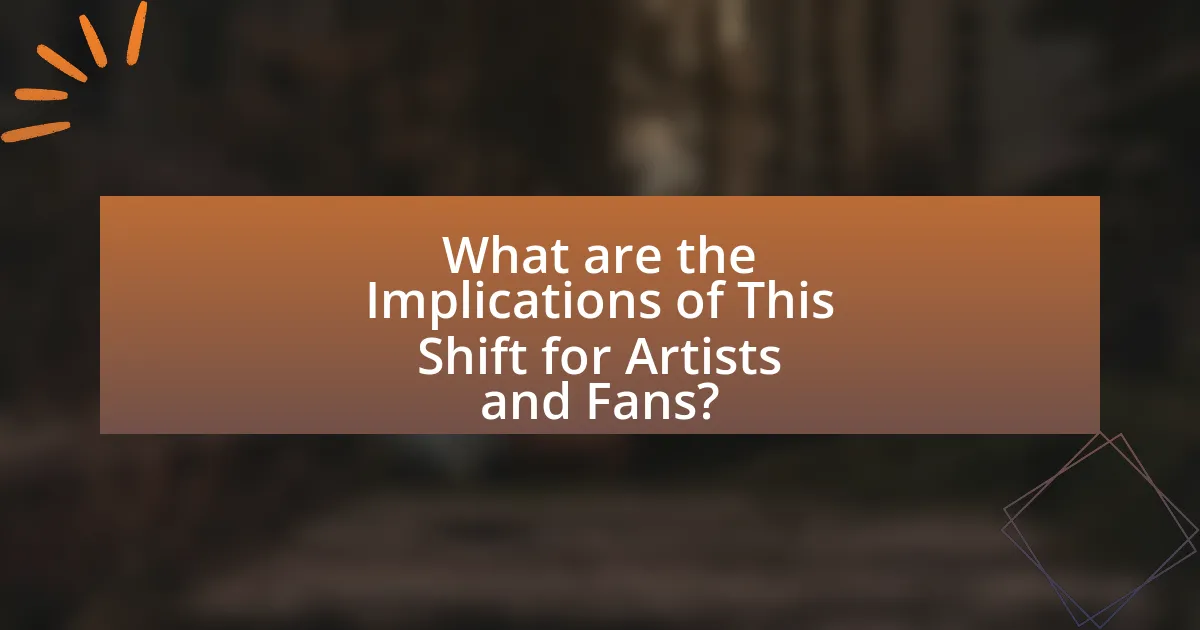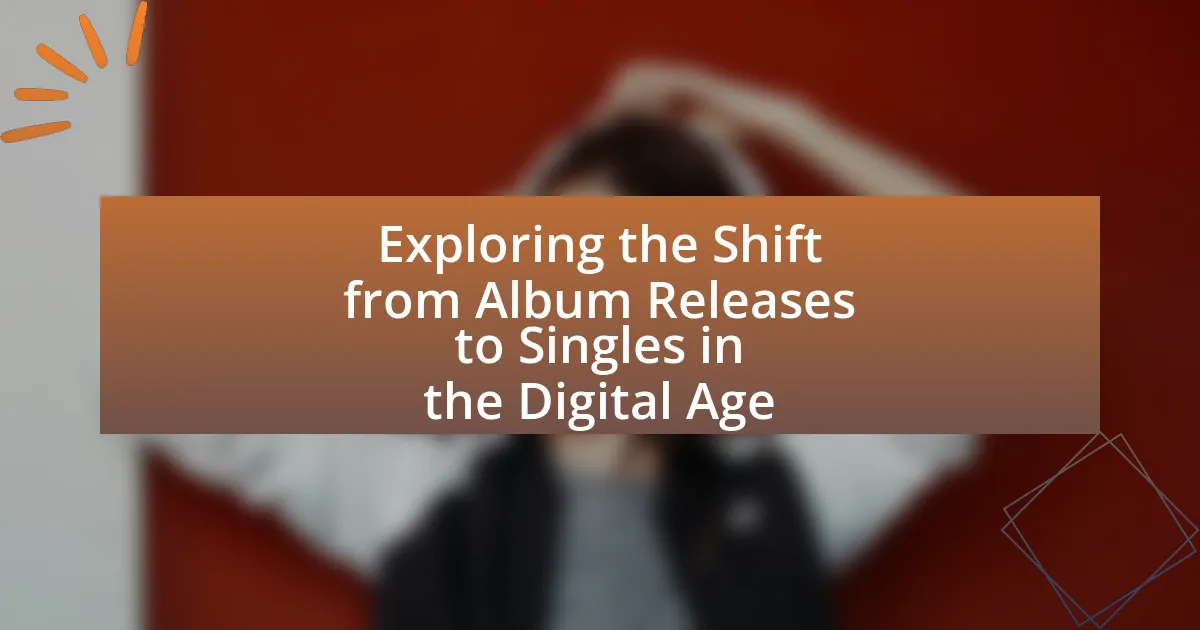The article examines the significant shift from album releases to singles in the digital age, driven by the rise of streaming platforms and changing consumer behaviors. It highlights how platforms like Spotify and Apple Music prioritize singles, leading to increased visibility and engagement for artists. The article discusses the financial implications of releasing singles, the impact of social media and digital marketing on music promotion, and the challenges artists face in maintaining a cohesive artistic vision. Additionally, it explores how this trend affects audience engagement and the overall music industry landscape, emphasizing the evolving dynamics of music consumption in a digital context.

What is the Shift from Album Releases to Singles in the Digital Age?
The shift from album releases to singles in the digital age is characterized by artists prioritizing the release of individual tracks over full albums. This change is driven by the rise of streaming platforms, which allow listeners to access music instantly and favor shorter, more frequent releases. According to a report by Nielsen Music, in 2020, single track sales accounted for 80% of all music sales, highlighting the growing preference for singles. Additionally, platforms like Spotify and Apple Music promote singles through curated playlists, further incentivizing artists to focus on standalone songs rather than traditional album formats. This trend reflects the evolving consumption habits of listeners who seek immediate gratification and diverse musical experiences.
How has the music consumption landscape changed in recent years?
The music consumption landscape has shifted significantly in recent years, primarily moving from traditional album releases to a focus on singles. This change is driven by the rise of streaming platforms, which accounted for 83% of the U.S. music industry’s revenue in 2022, according to the Recording Industry Association of America. As a result, artists are increasingly releasing singles to maintain listener engagement and capitalize on the algorithm-driven nature of streaming services, which favor frequent releases over full albums. This trend reflects a broader consumer preference for easily accessible, bite-sized content that fits into modern listening habits.
What role do streaming platforms play in this shift?
Streaming platforms significantly influence the shift from album releases to singles by prioritizing immediate access and consumption of music. These platforms, such as Spotify and Apple Music, utilize algorithms that promote individual tracks over full albums, encouraging artists to release singles more frequently to maintain visibility and engagement. Data from the Recording Industry Association of America (RIAA) indicates that streaming now accounts for over 80% of music industry revenue, highlighting the economic incentive for artists to focus on singles. This model aligns with consumer behavior, as listeners increasingly prefer curated playlists and shorter listening experiences, further solidifying the role of streaming platforms in this transition.
How do social media and digital marketing influence music releases?
Social media and digital marketing significantly influence music releases by enhancing visibility and engagement for artists. Platforms like Instagram, TikTok, and Twitter allow musicians to connect directly with fans, creating buzz around new releases through targeted campaigns and viral content. For instance, TikTok has become a powerful tool for music promotion, with songs often gaining popularity through user-generated content, leading to increased streaming numbers. According to a report by the Recording Industry Association of America, digital music revenue grew by 12% in 2020, largely driven by social media marketing strategies that promote singles over traditional album releases. This shift reflects a broader trend where artists prioritize singles to maintain relevance and capitalize on the fast-paced consumption habits of digital audiences.
Why are artists increasingly favoring singles over albums?
Artists are increasingly favoring singles over albums due to the changing dynamics of music consumption and the digital landscape. The rise of streaming platforms has shifted listener behavior towards favoring shorter, more frequent releases, as singles allow artists to maintain visibility and engagement with their audience. According to a 2021 report by the International Federation of the Phonographic Industry, singles accounted for 80% of global music consumption, highlighting the preference for bite-sized content. This trend enables artists to respond quickly to market trends and audience preferences, maximizing their reach and potential revenue.
What are the financial implications of releasing singles?
Releasing singles can lead to increased revenue streams and lower production costs compared to full album releases. Singles typically require less investment in production and marketing, allowing artists to allocate resources more efficiently. For instance, the average cost to produce a single can range from $1,000 to $10,000, while an album may cost upwards of $20,000 to $100,000. Additionally, singles can generate quicker returns on investment through streaming platforms, where artists earn per stream, thus capitalizing on immediate audience engagement. According to the Recording Industry Association of America (RIAA), streaming revenue has surpassed physical sales, highlighting the financial viability of singles in the current market.
How does audience engagement differ between singles and albums?
Audience engagement differs significantly between singles and albums, primarily due to the consumption patterns and attention spans of listeners. Singles typically generate immediate interest and engagement, as they are often released with promotional campaigns that capitalize on social media and streaming platforms, leading to quick spikes in listens and shares. In contrast, albums tend to foster deeper engagement over a longer period, as listeners explore multiple tracks and themes, often resulting in sustained discussions and analyses within fan communities.
Research indicates that singles can achieve higher initial streaming numbers; for instance, a 2020 report by the International Federation of the Phonographic Industry noted that 75% of music consumption was driven by singles, reflecting their ability to capture attention quickly. Conversely, albums, while slower to gain traction, can create a more immersive experience, as evidenced by the fact that albums with cohesive narratives often lead to increased fan loyalty and long-term engagement.
What impact does this shift have on the music industry as a whole?
The shift from album releases to singles in the digital age significantly alters the music industry by prioritizing immediate consumption and streaming metrics over traditional album sales. This change leads to artists focusing on releasing multiple singles to maintain listener engagement and capitalize on streaming platforms, which favor frequent releases. For instance, data from the Recording Industry Association of America (RIAA) shows that streaming now accounts for over 80% of music industry revenue, highlighting the importance of singles in driving financial success. Consequently, this shift encourages a more fragmented listening experience, where listeners may engage with individual tracks rather than entire albums, ultimately reshaping marketing strategies and revenue models within the industry.
How are record labels adapting to the trend of singles?
Record labels are adapting to the trend of singles by shifting their marketing strategies and release schedules to prioritize individual tracks over full albums. This adaptation is evident as labels increasingly focus on digital platforms, where consumers prefer to stream or purchase singles rather than albums. For instance, data from the Recording Industry Association of America (RIAA) shows that single-track downloads and streaming have significantly outpaced album sales, prompting labels to invest more in promoting standalone songs. Additionally, record labels are collaborating with artists to release frequent singles, allowing for continuous engagement with audiences and leveraging social media for targeted marketing campaigns.
What changes are occurring in artist promotion and marketing strategies?
Artist promotion and marketing strategies are increasingly focusing on digital platforms and data-driven approaches. This shift is driven by the rise of streaming services, which have changed how music is consumed, leading artists to prioritize single releases over traditional album formats. For instance, according to a report by the Recording Industry Association of America (RIAA), streaming accounted for 83% of the U.S. music industry’s revenue in 2021, highlighting the importance of digital presence. Additionally, social media platforms like TikTok and Instagram have become essential tools for artists to engage with audiences, promote their music, and create viral trends, further emphasizing the need for innovative marketing strategies that leverage these channels.

What are the Key Factors Driving the Shift to Singles?
The key factors driving the shift to singles include the rise of digital streaming platforms, changing consumer behavior, and the need for artists to maintain relevance. Digital streaming services like Spotify and Apple Music prioritize singles, allowing listeners to access music quickly and easily, which has led to a preference for shorter releases. Additionally, consumer behavior has shifted towards on-demand content, with audiences favoring immediate gratification over traditional album formats. This shift is supported by data indicating that singles account for a significant portion of music consumption, with reports showing that over 70% of music streams are for individual tracks rather than full albums.
How do consumer preferences shape the trend towards singles?
Consumer preferences significantly shape the trend towards singles by prioritizing convenience and immediate gratification in music consumption. As digital platforms like Spotify and Apple Music allow users to access individual tracks easily, listeners increasingly favor singles over full albums, reflecting a desire for quick and accessible content. Data from the Recording Industry Association of America (RIAA) indicates that in 2020, single track sales accounted for 80% of all digital music sales, highlighting this shift. This preference for singles is further driven by social media trends, where short, catchy songs often go viral, reinforcing the appeal of standalone tracks over longer formats.
What demographic factors influence the popularity of singles?
The popularity of singles is influenced by demographic factors such as age, gender, and geographic location. Younger audiences, particularly those aged 18 to 34, tend to prefer singles due to their accessibility on streaming platforms and social media, which cater to shorter attention spans. Gender differences also play a role, as studies indicate that female listeners are more likely to engage with pop singles, while male listeners may gravitate towards genres like hip-hop and rock. Additionally, geographic location affects music preferences, with urban areas showing a higher consumption of singles compared to rural regions, where album formats may still hold more appeal. These demographic trends are supported by data from the Recording Industry Association of America, which highlights the increasing consumption of singles over albums in recent years.
How does the attention span of listeners affect music release strategies?
The attention span of listeners significantly influences music release strategies by prompting artists and labels to favor singles over full albums. Research indicates that the average attention span for consuming digital content has decreased, with studies showing that listeners often prefer shorter, more digestible formats. This shift leads to a strategy where artists release singles more frequently to maintain engagement and capitalize on fleeting listener interest, as evidenced by the rise of platforms like Spotify, which prioritize playlists and single tracks over traditional album formats. Consequently, the focus on singles allows for more consistent audience interaction and maximizes streaming opportunities, aligning with the consumption habits of modern listeners.
What technological advancements support the rise of singles?
Technological advancements such as streaming platforms, social media, and digital distribution have significantly supported the rise of singles. Streaming platforms like Spotify and Apple Music allow artists to release singles quickly and reach a global audience, facilitating immediate access to new music. Social media enables artists to promote their singles directly to fans, creating buzz and engagement without the need for traditional marketing. Additionally, digital distribution services streamline the process of releasing music, allowing artists to bypass record labels and release singles independently. These advancements have transformed the music industry, making singles a more viable and popular format for both artists and listeners.
How do algorithms and playlists on streaming services impact single releases?
Algorithms and playlists on streaming services significantly influence single releases by determining which tracks are promoted to listeners, thereby affecting their visibility and streaming numbers. Streaming platforms like Spotify and Apple Music utilize algorithms that analyze user behavior, preferences, and listening patterns to curate personalized playlists, which can lead to increased exposure for singles. For instance, a single featured on a popular playlist can experience a surge in streams, often translating to higher chart positions and greater commercial success. Data from Spotify indicates that tracks included in their editorial playlists can see an increase of up to 300% in streams, highlighting the direct impact of algorithm-driven playlist placements on single releases.
What role does data analytics play in shaping release strategies?
Data analytics plays a crucial role in shaping release strategies by providing insights into consumer behavior and preferences. By analyzing streaming data, social media interactions, and sales trends, artists and labels can identify the optimal timing and format for releasing music. For instance, a study by Nielsen Music found that 70% of listeners prefer singles over albums, indicating a shift in consumer preference that data analytics can help navigate. This data-driven approach allows for targeted marketing efforts and strategic release schedules that align with audience engagement patterns, ultimately maximizing reach and revenue.

What are the Implications of This Shift for Artists and Fans?
The shift from album releases to singles in the digital age significantly impacts both artists and fans. For artists, this change allows for more frequent engagement with their audience, as they can release new music more regularly without the lengthy process of creating a full album. This strategy can lead to increased visibility and potentially higher streaming numbers, as evidenced by the rise of platforms like Spotify, which favor single tracks in their playlists. For fans, this shift means access to new music more often, fostering a continuous connection with their favorite artists. However, it may also lead to a fragmented listening experience, as fans might miss out on the cohesive storytelling often found in albums. Overall, this transition reflects the evolving dynamics of music consumption in a digital landscape.
How does the shift to singles affect an artist’s creative process?
The shift to singles significantly alters an artist’s creative process by encouraging more frequent and focused songwriting. Artists often concentrate on creating individual tracks that resonate with current trends and audience preferences, rather than developing a cohesive album narrative. This change is supported by data indicating that streaming platforms prioritize singles, leading to increased visibility and engagement for artists. Consequently, artists may experiment with diverse styles and collaborate more frequently, adapting their creative output to maintain relevance in a fast-paced digital landscape.
What are the challenges artists face when focusing on singles?
Artists face several challenges when focusing on singles, primarily related to market saturation and promotional costs. The digital landscape is crowded, making it difficult for individual singles to stand out among numerous releases; in 2021, over 60,000 tracks were uploaded to Spotify daily, highlighting the intense competition. Additionally, the financial burden of marketing each single can be significant, as artists must invest in promotional strategies to gain visibility, which can strain limited budgets. Furthermore, the focus on singles can lead to a lack of cohesive storytelling that albums traditionally provide, potentially impacting audience engagement and artist identity.
How can artists maintain a cohesive artistic vision with single releases?
Artists can maintain a cohesive artistic vision with single releases by establishing a clear thematic and stylistic framework that guides each release. This framework can include consistent lyrical themes, visual aesthetics, and sound palettes that resonate across individual singles. For instance, artists like Billie Eilish have successfully used a distinct visual style and thematic continuity in their singles, which reinforces their overall artistic identity. Additionally, planning a series of singles that collectively tell a story or explore a specific concept can further enhance cohesion, as seen in the approach of artists like Hozier, who released singles that align with the narrative of his albums. By strategically curating their releases and ensuring each single contributes to a larger artistic narrative, artists can effectively maintain a cohesive vision in the digital age.
What are the benefits for fans in this new music landscape?
Fans benefit significantly in the new music landscape by gaining access to a wider variety of music and more frequent releases. This shift from traditional album releases to singles allows fans to discover new artists and songs more easily, as streaming platforms like Spotify and Apple Music curate personalized playlists and recommendations based on listening habits. Additionally, the increased frequency of releases keeps fans engaged and excited about new content, as artists can respond quickly to trends and audience feedback. According to a report by Nielsen Music, the consumption of singles has surged, with singles accounting for over 70% of music consumption in recent years, highlighting the preference for this format among listeners.
How does the availability of singles enhance fan engagement?
The availability of singles enhances fan engagement by providing fans with more frequent and immediate access to new music. This immediacy fosters a continuous connection between artists and their audience, as fans can engage with new content regularly rather than waiting for full album releases. Research indicates that artists who release singles more frequently can maintain higher visibility and relevance in a crowded digital landscape, leading to increased streaming numbers and social media interactions. For instance, a study by Nielsen Music found that singles accounted for 70% of all music consumption in 2020, demonstrating the significant role singles play in keeping fans engaged and invested in an artist’s work.
What new opportunities do fans have to discover music in the digital age?
Fans have new opportunities to discover music in the digital age through streaming platforms, social media, and algorithm-driven recommendations. Streaming services like Spotify and Apple Music offer personalized playlists and curated content based on listening habits, allowing fans to explore new artists and genres easily. Social media platforms, such as TikTok and Instagram, enable users to share music and discover trending songs through viral challenges and posts. Additionally, data analytics and machine learning algorithms enhance the discovery process by suggesting tracks that align with individual preferences, making it easier for fans to find music that resonates with them.
What best practices should artists consider when releasing singles?
Artists should consider a strategic release plan when launching singles, which includes timing, marketing, and audience engagement. Timing is crucial; releasing singles on Fridays aligns with industry standards, maximizing visibility. Marketing efforts should encompass social media promotion, music videos, and collaborations with influencers to reach broader audiences. Engaging with fans through pre-release teasers and interactive content can build anticipation and foster a loyal following. Additionally, utilizing streaming platforms effectively, such as submitting tracks for playlists, can significantly enhance exposure. According to a 2021 report by the International Federation of the Phonographic Industry, singles accounted for 75% of global music consumption, highlighting the importance of a focused approach in the digital age.
